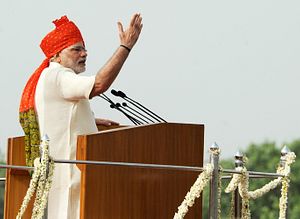On November 8, 2016, Indian Prime Minister Narendra Modi, in a stunning surprise announcement, declared that 500 and 1,000 rupee notes were to be demonetized (i.e., removed from circulation as legal tender). In the interest of eliminating tax evasion by targeting so-called “black money” and monetary fraud, he set a 50-day target for exchanging the old notes for new ones, in theory allowing the cash-dependent aspects of the Indian economy time to get back on their feet. On New Year’s Eve, in his address to the Indian nation, he delivered his second major speech on the topic of demonetization and, in some ways, left the Indian people with just as many questions as before and no significant new answers.
The drive for demonetization began as an explicit war against black money in the words of the government, with references to currency fraud and terror funding interspersed. Over time the rhetoric evolved to hint at a grander vision – a move towards a less cash dependent and more digitized society. The New Year’s Eve address, on the other hand, focused extensively on the black money agenda.
Modi began by thanking the people of the country, across caste and class barriers, for their patient support of this policy and called them crusaders against evil. Emphasizing that the events of the past two months have been indicative of the fact that the people and the government are on the same side of this battle, rather than at loggerheads, he said that the scores of letters he received regarding demonetization were a sign that people trusted the government with their problems and that they were willing to show their support and walk “shoulder to shoulder” with the authorities.
While Modi praised bank employees and other important members of the financial sector for their tireless work in handling the panic and rush associated with demonetization, he also made a commitment to bringing the Indian economy back to its feet. However, here lay the problem.
When speaking of demonetization as a crusade against evil, neither he nor his government nor the Reserve Bank of India has released clear figures on how helpful the 50-day period has been in the government’s attempt to weed out black money. While promising that the banking system will go back to a state of normalcy in early 2017, Modi did not commit to a timeline or in any way indicate what “early” meant here. While lauding the poor, farmers, and other aggrieved sections of society for their forbearance, he did not mention the wreckage that India’s thriving informal economy faced during this period, much less unveil steps toward addressing the damage. In so many ways therefore, Modi skirted around the criticism levied against what stands to be his landmark policy and addressed the nation with his trademark vigorous rhetorical style.
The latter half of his speech finally addressed policies for disadvantaged groups, specifically related to loans and housing. Favorable interest rates will be offered through two new categories of loans and the number of houses built for the poor under the existing government scheme Pradhan Mantri Awaas Yojana will be increased by 33 percent, Modi said. His government has also committed to increasing Indian farmers’ access to loans through cooperatives and farmers who currently participate in the government Kisaan Credit Card scheme will be offered RuPay debit cards that can be used anywhere without depending on a bank. Programs providing financial assistance to pregnant women have moreover been newly prioritized and a new scheme for senior citizens that guarantees fixed interest rates for a ten-year period has also been launched.
Modi concluded his address by once more touching upon the theme of corruption, especially in the context of the elections, hinting at the need for simultaneous conduct of both state and national elections. He urged parties to prioritize transparency and argued that the battle against black money and corruption is holding back the country from its full potential, ending with a plea to for all Indians to come together to remove obstacles.
India steps into the new year thus on the back of the unsettling short-term consequences of demonetization. It remains to be seen whether the hitherto vague promises and strong rhetoric unveiled by the government so far will translate into observable recovery – and if so, when.

































